
The Prospect of Whitby is a historic public house on the northern bank of the River Thames at Wapping, in the East End of London and the London Borough of Tower Hamlets. It lays claim to being the site of the oldest riverside tavern, dating from around 1520.
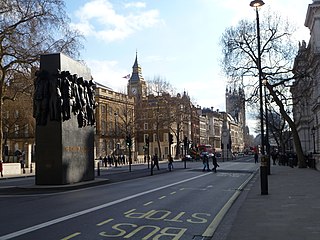
Whitehall is a road and area in the City of Westminster, Central London, England. The road forms the first part of the A3212 road from Trafalgar Square to Chelsea. It is the main thoroughfare running south from Trafalgar Square towards Parliament Square. The street is recognised as the centre of the Government of the United Kingdom and is lined with numerous departments and ministries, including the Ministry of Defence, Horse Guards and the Cabinet Office. Consequently, the name "Whitehall" is used as a metonym for the British civil service and government, and as the geographic name for the surrounding area.

Covent Garden is a district in London, on the eastern fringes of the West End, between St Martin's Lane and Drury Lane. It is associated with the former fruit-and-vegetable market in the central square, now a popular shopping and tourist site, and with the Royal Opera House, itself known as "Covent Garden". The district is divided by the main thoroughfare of Long Acre, north of which is given over to independent shops centred on Neal's Yard and Seven Dials, while the south contains the central square with its street performers and most of the historical buildings, theatres and entertainment facilities, including the London Transport Museum and the Theatre Royal, Drury Lane.
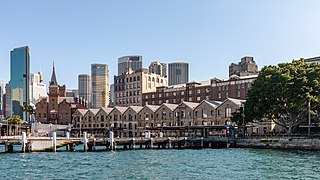
The Rocks is a suburb, tourist precinct and historic area of Sydney's city centre, in the state of New South Wales, Australia. It is located on the southern shore of Sydney Harbour, immediately north-west of the Sydney central business district.

Billingsgate Fish Market is located in Poplar in London. It is the United Kingdom's largest inland fish market. It takes its name from Billingsgate, a ward in the south-east corner of the City of London, where the riverside market was originally established. In its original location in the 19th century, Billingsgate was the largest fish market in the world.
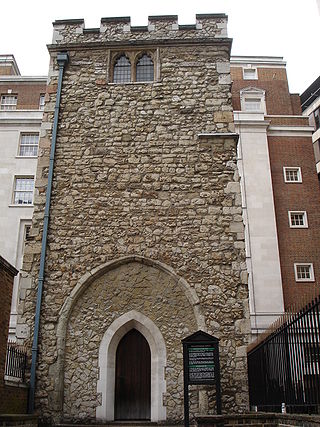
All Hallows Staining was a Church of England church located at the junction of Mark Lane and Dunster Court in the north-eastern corner of Langbourn ward in the City of London, England, close to Fenchurch Street railway station. All that remains of the church is the tower, built around AD 1320 as part of the second church on the site. Use of the grounds around the church is the subject of the Allhallows Staining Church Act 2010.

Montagu House in Whitehall, Westminster, London, England, was the town house built by John Montagu, 2nd Duke of Montagu (1690–1749), whose country seat was Boughton House in Northamptonshire.

A coffee palace was an often large and elaborate residential hotel that did not serve alcohol, most of which were built in Australia in the late 19th century.
Events from the year 1631 in England.

Pembroke House, located on Whitehall, was the London residence of the earls of Pembroke.

The Old Queen's Head is a pub on Essex Road in Islington, London N1. Its shopfront is scheduled as "to be retained" by Islington Council. Since 2006 The Old Queens Head has been a part of The Columbo Group, owned by Steve Ball and Riz Shaikh. It is a Grade II listed building.

The Albert is a Grade II listed pub located at 52 Victoria Street in Victoria, London, about 0.4 miles (0.64 km) southwest of Westminster Abbey. Built in 1862 by the Artillery Brewery, the pub retains its striking façade and Victorian features that were undamaged during The Blitz in World War II. The Albert was named in tribute to Queen Victoria's husband, Albert, Prince Consort.
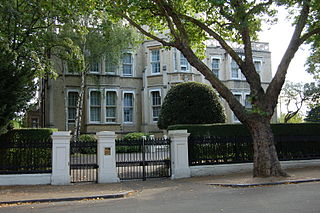
13 Kensington Palace Gardens, also known as Harrington House, is the former London townhouse of the Earls of Harrington. It is now the official residence of the Russian Ambassador. There were earlier Harrington Houses in London, located at Craig's Court, Charing Cross and at Stable Yard, St James's.

The Town of Ramsgate public house is located at the centre of the ancient hamlet of Wapping in the London Borough of Tower Hamlets. It features in several books about London inns where it is rated as "a notable specimen of a waterman's tavern."

In British usage, the term townhouse originally referred to the opulent town or city residence of a member of the nobility or gentry, as opposed to their country seat, generally known as a country house or, colloquially, for the larger ones, stately home. The grandest of the London townhouses were stand-alone buildings, but many were terraced buildings.
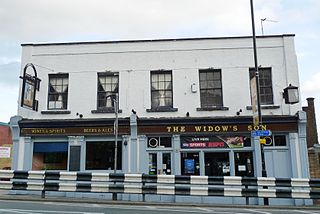
The Widow's Son is a Grade II* listed public house at 75 Devons Road, in Bromley-by-Bow, East London. It was built in the early 19th century, possibly 1848, and the existing building is supposedly on the site of an old widow's cottage.

The White Lion is a public house in St Albans, Hertfordshire, England. In 2015 the pub was owned by Punch Taverns.

The Model Factory and Dwelling is a heritage-listed former factory, store and dwelling and now offices located at 120 Gloucester Street in the inner city Sydney suburb of The Rocks in the City of Sydney local government area of New South Wales, Australia. It was designed by George McRae and built from 1912 to 1913. It is also known as Chung Lun Building and (erroneously) the Housing Board Building. The property is owned by Property NSW, an agency of the Government of New South Wales. It was added to the New South Wales State Heritage Register on 10 May 2002.

Craig's Court is a courtyard off Whitehall in central London containing the grade II* listed Harrington House (c.1692), other listed buildings, and the British Telecom Whitehall telephone exchange of which Harrington House forms a part. It was built by Joseph Craig in the late 1690s on land that had once been the location of the Hermitage of St Katherine.




















